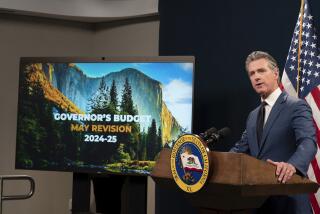Index Overstates Inflation Rate, U.S. Panel Finds
A congressional commission will report today that the government’s measure of inflation for the cost of living is overstated by 1.1 percentage points a year, enough to cost the U.S. Treasury billions of dollars in extra payments for Social Security and other benefit programs.
The commission, headed by Michael J. Boskin, head of the Council of Economic Advisors in the Ford administration and now a Stanford University economist, will report that the current consumer price index (CPI) misstates the true measure of inflation. The overall error could range from 0.8% to 1.6%, but is most likely to be expressed at 1.1%, knowledgeable sources said Tuesday.
If the commission’s recommended changes are adopted, they will affect every American wage earner and retiree. Social Security benefits and military and civilian government pensions, all pegged to the CPI, would grow more slowly. Taxes would rise, because individual brackets are also pegged to the index.
At the same time, federal coffers would swell, boosting efforts to eliminate the budget deficit. If the Boskin proposals were adopted, the 1 percentage point cut in the CPI could give the government as much as $600 billion in savings over 10 years.
But a number of factors make such large-scale changes remote. Political leaders, including President Clinton and congressional Republicans, are reluctant to support the sort of legislative changes the report recommends. Those revisions would draw opposition from powerful groups, including the elderly.
In addition, the government experts who calculate the inflation figure have already made revisions and are preparing more changes to increase the accuracy of the monthly CPI, although the changes are much smaller than those recommended by the commission.
If the commission’s controversial conclusion is correct, the 2.6% inflation rate reported for last year would actually have been 1.5%. The CPI, reflecting a market basket of goods and services purchased by urban consumers, is the standard measure to track changes in the cost of living.
The commission, appointed by the Senate Finance Committee, will recommend specific steps for the government to adopt to prepare a more accurate reflection of inflation. A 1 percentage point reduction in the CPI could save the government billions of dollars in the effort to balance the federal budget.
Each year, the 43 million Social Security beneficiaries get a cost-of-living allowance directly linked to changes in the consumer price index. That increase has been regarded as artificially high for some time. In the past, some officials have suggested limiting the Social Security increase to the CPI, minus 1 percentage point.
But that would stir a political hornet’s nest. The average beneficiary could lose $5,000 over 10 years, said Evelyn Morton, a lobbyist for the 32-million member American Assn. of Retired Persons.
“Not only would people lose money in the first year when they get a smaller increase, but there is a cumulative impact for years because the base is smaller,” Morton said.
Senate Majority Leader Trent Lott (R-Miss.) said Tuesday that if any changes come, Clinton must take the lead. “We probably would not do it alone,” he said. “I think that’s something we need to do together.”
But the administration shows little intention of taking the political risk. Budget director Franklin Raines recently restated the administration belief that changes should come from the technical experts rather than through an act of Congress.
Rep. Bill Archer (R-Texas), chairman of the House Ways and Means Committee, also has declared his opposition to any legislation mandating a change in the consumer price index.
The fate of the proposal most likely will rest with the professionals at the Labor Department’s Bureau of Labor Statistics, who prepare the CPI. They disagree with the Boskin analysis, and are convinced any error is much smaller.
“We are well aware of the issues,” said Patrick Jackman, a BLS economist. Much of the Boskin commission’s estimate rests on the premise that the current CPI does not sufficiently incorporate improvements in the quality of goods over the years. Labor officials believe there is not enough evidence to make the kind of major adjustment the Boskin panel recommends.
The Labor Statistics Bureau adjusted its survey in January of last year and again this year to make more precise calculations of inflation in food consumed at home, shelter and medical care. The changes will have a long-term impact of reducing the CPI growth by two-tenths of 1% annually.
Other improvements are being made in technical factors that could produce additional changes. But the likely result, although it will be higher than the two-tenths of 1%, will still fall far below the Boskin proposals.
“This is a technical issue that ought to be evaluated by technicians who do this on a full-time basis,” Morton said. “When they make the adjustments, we have no criticism.”
The CPI always lags somewhat because it is based on a relatively old survey. Once a decade, the government spends millions of dollars to survey Americans about what they buy and consume. The current market basket index is based on consumer buying patterns in 1982-84.
Each month, the government surveys a sample of stores and outlets to find the price for the items in the basket. The change is the measure of the inflation rate.
The next revision in the market basket, covering spending patterns between 1993 and 1995, will be issued in 1998. Meanwhile, the technicians tinker with minor changes to attempt a higher degree of accuracy.
More to Read
Get the L.A. Times Politics newsletter
Deeply reported insights into legislation, politics and policy from Sacramento, Washington and beyond. In your inbox three times per week.
You may occasionally receive promotional content from the Los Angeles Times.






